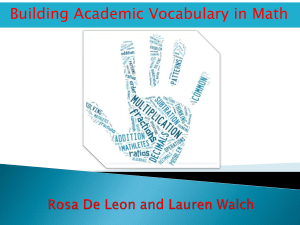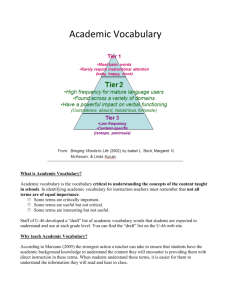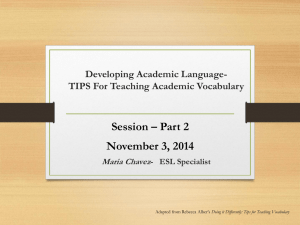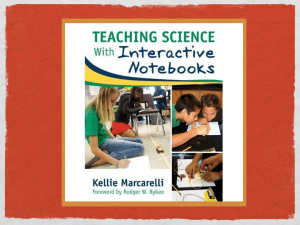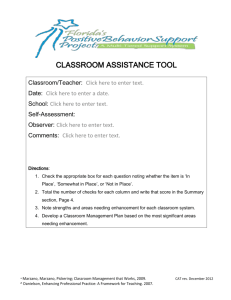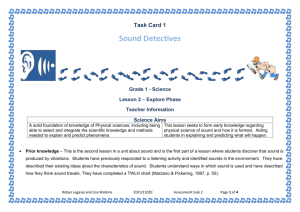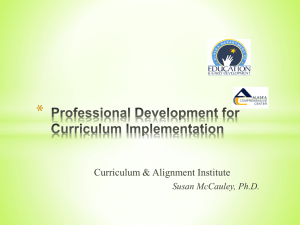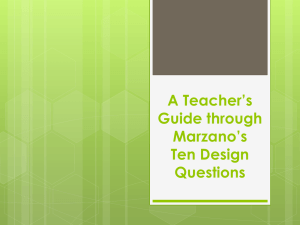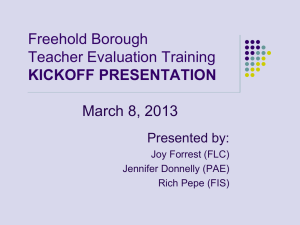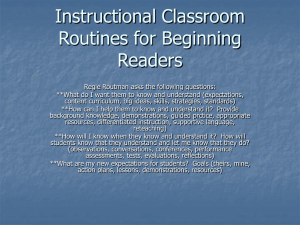Session Starter - Free Association - fhsdvocabulary
advertisement
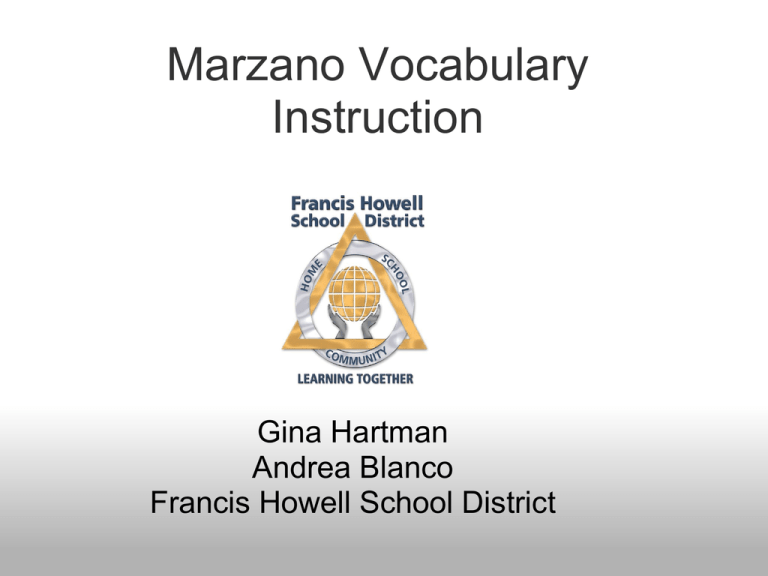
Marzano Vocabulary Instruction Gina Hartman Andrea Blanco Francis Howell School District Session Starter - Free Association • Participants will be provided a target term. • Each member of your table group will take turns saying any word that comes to mind related to the target term. • When the facilitator tells you stop, the last person to say a word will explain how that word is related to the target. (Marzano & Pickering, 2005) During this session we will..... • Become familiar with the Marzano Six-Steps of Vocabulary Instruction. • Become familiar with strategies and resources that align to the six steps. • Develop and share a plan to make vocabulary instruction common practice in your building/classroom. Carving is appropriate for most green and blue slopes and even some black slopes. However, if you try to carve through moguls, especially in packed powder or corn snow, you're going to face-plant. (Marzano & Pickering, 2005) Carving is appropriate for most green and blue slopes and even some black slopes. However, if you try to carve through moguls, especially in packed powder or corn snow, you're going to face-plant. (Marzano & Pickering, 2005) • Research shows a student in the 50th percentile in terms of ability to comprehend the subject matter taught in school, with no direct vocabulary instruction, scores in the 50th percentile ranking. • The same student, after specific content-area terms have been taught in a specific way, raises his/her comprehension ability to the 83rd percentile. (Marzano & Pickering, 2005) Marzano, R.J., & Pickering, D.J. (2005). Building academic vocabulary teacher's manual. Alexandria, VA: Association for Supervision and Curriculum Development. fhsdvocabulary.pbworks.com • Show video • Before providing information, try to determine student's background knowledge Use KWHL charts, activities to activity prior knowledge (see wiki) • Do not provide students with a formalized definition. • Use both linguistic-and nonlinguistic approaches 1. Write the term 2. Rate their knowledge of the term 3. Write examples, descriptions, or explanations of the term. 4. Draw a picture of the term 5. Add new items to the term as they are discussed in class. Let's practice using the vocabulary notebook. Your word is...impudent. • Show video • Non-linguistic • May need some guidance and modeling if students are not accustomed to creating pictures and graphics for ideas. • Technology can aid in the construction of non-linguistic representations • Video Clip • Specific activities should be planned by the teacher to periodically review the targeted terms. • Each time students engage in these activities, they should be provided opportunities to add to, or revise, the entry for the term in their academic notebooks. Activity Suggestions • • • • • Free Association Comparing Activities Classifying Activities Analogy Activities Create Metaphors Classifying Activity 1 (Marzano & Pickering, 2005) • Give students a list of terms from their notebooks and ask them to classify the terms. • Example terms: o mesa, mountain, bay, ocean, canyon, hill, glen, forest, plain, port, canal, reservoir, stream, and prairie. Classifying Activity 2 (Marzano & Pickering, 2005) • Create categories for students and ask them to find terms from their notebooks that might fit into those categories. • Example: Ask students to identify people in history who were known for what they did for others or were known for caring more about themselves than about others. Classifying Activity 3 (Marzano & Pickering, 2005) • Ask students to review all of the terms in a section of their notebook and challenge them to create their own categories and classify the those terms. • Video Clip • The goal of this step is to encourage students to help each other identify and clear up misconceptions and confusions. • Remember, to encourage students to make additions or revisions to their notebook entries after the discussions. • The activities in this step can be unstructured or structured activities. Activity Suggestions • • • • • • Think-Pair-Share Should Partner Talking Chips ABC Graffiti Four Corners Give One, Get One • Stand up • Take 7 steps in any direction • Pick the nearest person that you don't know very well • Form a group of four by finding another group that you don't know very well • It is important to set aside blocks of time each week to play games in order to energize students and guide them in the review and use of important terms. Vocabulary Charades (Marzano & Pickering, 2005) • Please stand. • Using your arms, legs, and bodies, show the meaning of each term. http://www.flickr.com/photos/kohlerfolk/4112543671/in/photostream/ Talk a Mile a Minute (Marzano & Pickering, 2005) • Teams of 3-4 • Designate a “talker” for each round. • Try to get team to say each word by quickly describing them. • May not use words in category title or rhyming words. Shapes Square Circle Rectangle Triangle Right Triangle Oval Diamond Carleton, L., & Marzano, R.J. (2010). Vocabulary games for the classroom. Bloomington, IN: Marzano Research Laboratory. Puzzle Stories (Carleton & Marzano, 2010) 1.Split the class into small groups (3-5 students with mixed ability levels). 2.Provide a list of vocabulary terms to each group or display the terms on a whiteboard in the classroom. 3.Give each group a puzzle and have the students in each group put the puzzle together. 4.Each group of students will then write a story about the scene or object depicted in the puzzle using their vocabulary word list. 5.Have a representative from each group read the story aloud to the class. Example - Physics Class Exothermic - chemical reaction or compound occurring or formed with the evolution of heat. Endothermic -chemical reaction or compound occurring or formed with the absorption of heat. Definitions from http://www.thefreedictionary.com Image Source: http://www.evelinecharles.com/blog/evelinecharles-how-to-get-a-safe-summer-tan PowerPoint and SMART Board Review Games Don't forget about using your technology resources! Monitoring Student Learning • Move around the room while students work in notebooks. • Check student notebooks periodically. • Listen during review games and activities to correct inaccuracies. • Use student self-evaluation scoring guide. • Have a section for student self-reflection. Other Recommendations • Refer to the district curriculum or decide as a PLC which target terms you will focus on. • Keep the number of target terms within each subject area small (3 terms per week). • Make sure you allow students time to add to and modify their vocab notebooks. • Don't skip any steps in the process. • Time can be found by evaluating current practices. Summary Teaching specific terms in a specific way is the strongest action a teacher can take to ensure that students have the academic background knowledge that they need to understand the content in school. Activity Move around the room while the music is playing. When it stops, partner the person that is nearest to you. You and your partner will collaborate to answer the questions you have learned about the content this morning. Activity Questions • Describe the 6-Steps for teaching vocabulary instruction. • Discuss several ways you could assess the students prior knowledge. • Brainstorm four things you can have the students do to elaborate on the terms. How can you make effective vocabulary instruction common practice in your school or classroom?
